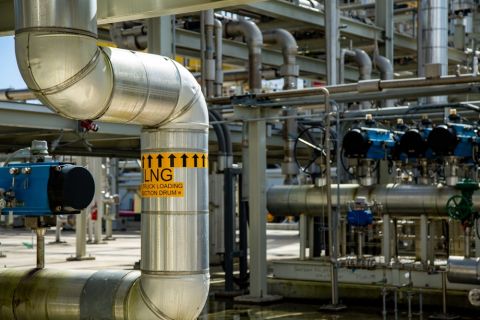In 2007, Petrobras announced the Tupi discovery in the Brazilian Santos basin with estimates of 5 to 8 Bbbl of oil to be recovered over the next 10 years. This announcement was significant because, prior to the discovery, the Santos basin offshore Brazil was thought to contain only natural gas. Needless to say, Tupi, the largest oil discovery in the Western Hemisphere in more than 30 years, has generated much enthusiasm and interest in the region, as well as a strong push to generate clearer images of the subsurface near and around the discovery.
Imaging the Santos basin is a challenging task due to the deep nature of the reservoir and the complexities of geology in the area. The Tupi discovery is presalt and deep below a complex overburden. CGGVeritas has been deploying and adapting new technology in the area to realize improvements in imaging, velocity model building, and input data preparation.

A Kirchhoff migration barely images BoS and presalt events under rugose ToS imaged using Kirchhoff (a) and RTM (b). RTM gives more continuous BoS and presalt events under rugose ToS. Both Kirchhoff and RTM images show high-frequency characteristics in the presalt region. (Images courtesy of the CGGVeritas multi-client data library)
Imaging advances
In 2009, CGGVeritas used reverse time migration (RTM) to resolve several challenges in the region. One obvious benefit to using RTM, according to the literature, is more accurate handling of complex structures without dip angle limitations. Unlike Kirchhoff migration, RTM also handles multi-arrivals and rapid spatial variations in the velocity model. The former is important because the rugose top of salt (ToS) scatters wavefields from the surface. The latter is necessary because such rapid variations in velocity are commonly found in the Santos basin.
The Santos basin also features geology that necessitates high-resolution (i.e. high-frequency) migrations to properly image it. Despite the compute-intensive nature of high-frequency RTM, the improvements in subsalt amplitudes are quite recognizable when imaging is not restricted to lower frequencies. High-frequency RTM is essential to image the presalt structures and stratigraphy in the Santos basin. Figure 1 demonstrates high-frequency characteristics in the presalt region and the significantly improved image with the RTM algorithm.
Even with a sophisticated RTM algorithm, inadequate acquisition illumination can create problems in regions of complex geology. In areas with poor illumination, noise and migration artifacts often contaminate the data and make interpretation difficult. Given a local geologic structure, however, it is often possible to determine the shot and receiver locations that could illuminate an area. In 2011, vector offset output (VOO) RTM was proposed to divide the RTM output of each shot into a number of tiles (typically nine), with each tile corresponding to a different vector offset range as measured from the shot location. This division of output differentiates the shots contributing signal from the shots contributing noise. Given the local structure, migration outputs from only the vector offsets that contribute to the signal are combined. An optimized VOO stack that combines only the illuminating outputs improves the signal-to-noise ratio and aids interpretation (Figure 2).

A full RTM stack (a) and RTM-optimized VOO stack (b) have both been migrated with a salt-flood velocity model. The optimized VOO stack produces a cleaner image of the BoS at this location.
Model building
Though employing RTM in the Santos basin can single-handedly make great improvements to subsalt imaging, the most impressive advances occur when it is coupled with a model building workflow tailored to the region. Model building sequences in other regions such as the Gulf of Mexico (GoM) do not suffice for the Santos basin because of its unique geological features. These features, starting with the shallow Albian layer, necessitate a custom model building sequence to progressively improve images in deeper sections. This flow contains distinctive features in sediment tomography, salt interpretation, and intrasalt/presalt velocity updating. Figure 3 compares RTM images migrated with two different velocity models, one created using a typical GoM flow and one with a flow customized for the Santos basin.
The reasons for the effectiveness of the flow are quite intuitive. First, the shallow sediment is not simple. The Albian layer present in the Santos basin has a higher velocity gradient than surrounding sediments, which follow a typical sediment compaction trend. A layer-constrained methodology was developed by CGGVeritas to allow for larger velocity variations than would be acceptable in surrounding sediments that exhibit typical compaction trends. Also, the high-resolution tomography, characterized by high-quality dense event picking, fine grid inversion, and mild model smoothing, can capture more details in the sediment. These details assist in determining an accurate sediment velocity, which in turn helps with more accurate ToS interpretation.
In addition to difficulties with the shallow sediment, the salt in the Santos basin poses several imaging challenges. Due to its rugosity and burial beneath a sequence of reflectors that mimic its undulations, the ToS in the Santos basin region can be difficult to interpret. Instead of a single sediment flood migration to use for its interpretation, an iterative approach is needed. CGGVeritas determined that the imaging of the base of salt (BoS) and presalt events are very sensitive to the interpretation of the ToS. The BoS is largely straight and simple throughout most of the region; thus, sagging or behavior that mimics the ToS act as flags for incorrect ToS interpretation. Therefore, the BoS and presalt events are critical for evaluating the accuracy of the ToS interpretation. With every modification to the ToS, a salt flood migration is performed to evaluate the improvements in the BoS and presalt events. In areas with complex salt structures such as steep salt flanks and overhangs, RTM provides better images. Thus it is natural to use RTM as an imaging tool in the salt interpretation stage. Often, complex salt leads to a lack of illumination, resulting in a poor seismic image. This image degradation severely hinders the interpreter’s ability to develop a complete and coherent salt interpretation. In such a scenario, multiple interpretation options can be evaluated, each with a migration result. Sometimes the solution is straightforward -- one option clearly provides the best image. However, just as often, a good scenario result indicates that further improvements can be made. This iterative salt interpretation approach leads to a better salt model and improved images.
The Santos basin salt exhibits layers of evaporites within the salt body. Not only do these evaporites display significant velocity differences, but they are relatively high-amplitude. This provides a perfect opportunity for updating the salt-layer velocity with tomography. During the intrasalt tomographic update, there is another advantage to using RTM. Recently RTM 3-D angle domain common image gathers (ADCIGs) were developed as an output from RTM. Unlike the commonly used 2-D angle gathers that are derived from an intermediate domain, 3-D angle gathers are generated directly and indexed by actual subsurface reflection angle and subsurface azimuth. Used as an input to tomography, these gathers provide better residual move-out information and lead to more accurate velocity updating. Just like in intrasalt tomography, RTM 3-D angle gathers also provide better results in presalt tomography. The use of RTM in each of the above iterations assists in interpretation, which renders a more accurate velocity model and results in improvements to presalt images. Incorporating iterative RTM into the custom model building flow is the key to its success.

In a stacked image using a velocity model determined by typical GoM model building flow (a) and an image using a model derived by Santos basin flow (b), BoS and presalt events are continuous and better focused. Events within the salt are better imaged, and BoS is more continuous.
Data preparation
RTM and velocity model building -- together -- make significant improvements to presalt images in the Santos basin region. However, we cannot overlook the importance of the input data preparation phase. Perhaps the most important step in preparation of the input data is multiple attenuation. Commonplace to this region is the presence of strong multiples. The water bottom, Albian layer, ToS, intrasalt reflectors, and BoS all generate multiples. The region is plagued by significant amounts of multiple energy -- both surface-related and interbed. Three-D surface-related multiple elimination is an effective technique to attenuate surface-related multiples and is widely used in the industry. However, interbed multiples, which do not reflect off the surface of the ocean, are still a challenge and frequently contaminate the presalt reservoir zones.
Due to the local geologic characteristics, a 3-D approach to multiple attenuation is important. Two methodologies for interbed multiple attenuation (IMA) can be applied in the Santos basin: one is model-driven, and the other is data-driven (Figure 4). These two methods have several similarities and one key difference. First, both methods are fully 3-D, equipping them to handle the complex geology. Second, they both predict multiples based on recorded primary reflections and adaptively subtract the predictions from the data. Third, both methods require identification of major multiple generators, often requiring a “safe” arbitrary horizon carefully located below an actual multiple-generating horizon.
The primary difference between the data-driven and the model-driven methods is that the data-driven method requires densely sampled input data or a robust interpolation and regularization algorithm. Though lending impressive results, the large data requirements make this method extremely compute-intensive. Alternatively, the model-driven method is much more efficient. It simply propagates the data along the path of the multiple. However, unlike the data-driven method, it requires a velocity model and reflectivity model.
RTM, a velocity model building flow that addresses specific geologic challenges in the region, and superior preparation of input data all act in harmony to improve images in the Santos basin. Clearer images of the reservoir zone result in increased confidence in understanding the area’s geology.
Recommended Reading
Battalion in Compliance with NYSE American after 2023 Meeting
2024-02-13 - Previously, Battalion Oil was not in compliance with the NYSE after failing to hold an annual meeting of stockholders during the fiscal year ending Dec. 31.
JMR Services, A-Plus P&A to Merge Companies
2024-03-05 - The combined organization will operate under JMR Services and aims to become the largest pure-play plug and abandonment company in the nation.
New Fortress Energy Sells Two Power Plants to Puerto Rico
2024-03-18 - New Fortress Energy sold two power plants to the Puerto Rico Electric Power Authority to provide cleaner and lower cost energy to the island.
Tellurian Executive Chairman ‘Encouraged’ by Progress
2024-03-18 - Tellurian announced new personnel assignments as the company continues to recover from a turbulent 2023.
Kissler: OPEC+ Likely to Buoy Crude Prices—At Least Somewhat
2024-03-18 - By keeping its voluntary production cuts, OPEC+ is sending a clear signal that oil prices need to be sustainable for both producers and consumers.





